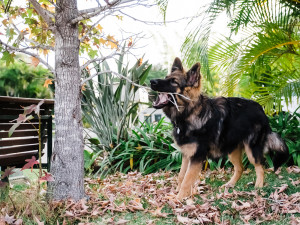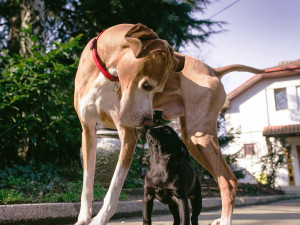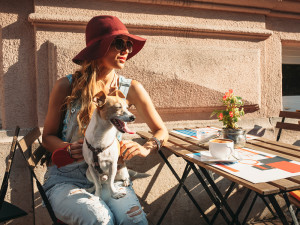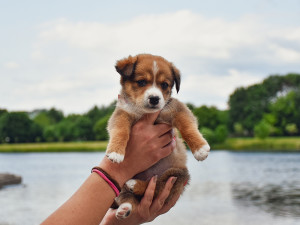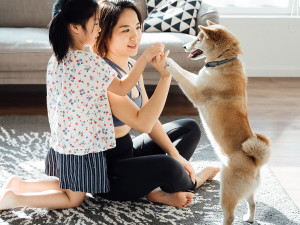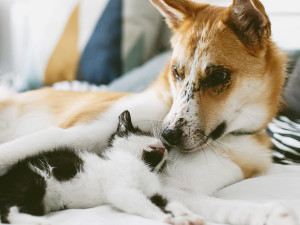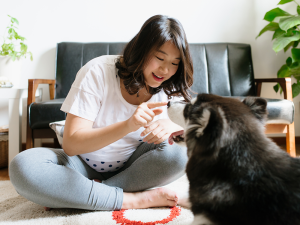How to Introduce Dogs
First impressions are very important.
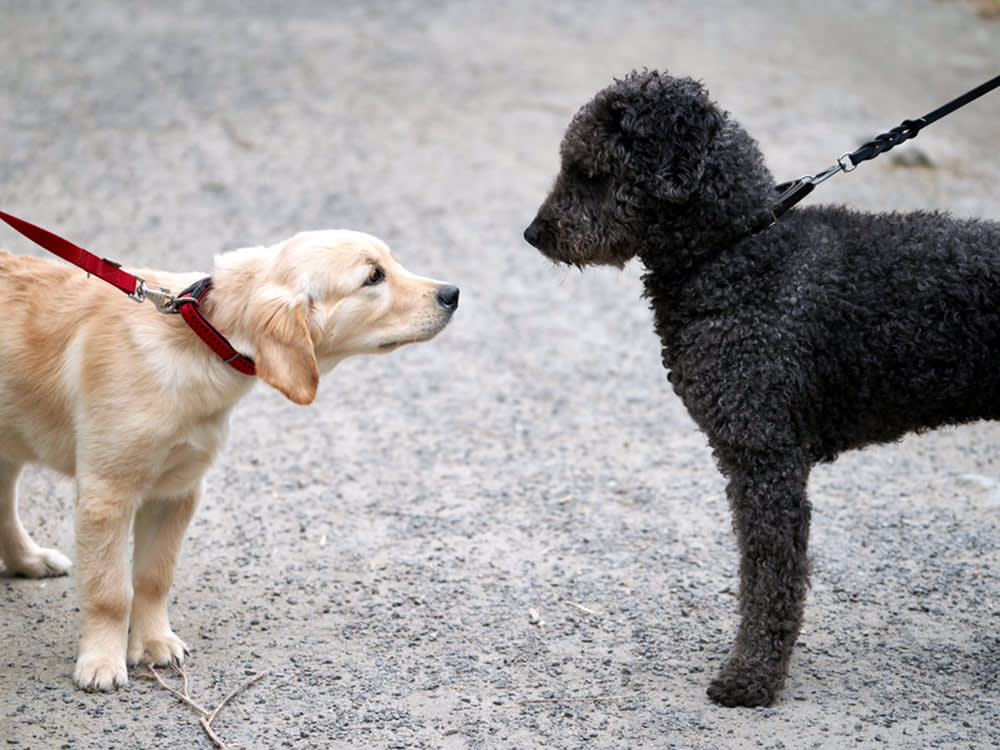
Share Article
In This Article:
How to Introduce Two Dogs How to Introduce A New Puppy to Your Dog How to Tell if Dogs Like Each Other How to Help Dogs Get Along
We all know how important first impressions are. When meeting someone new, you want to present yourself in the best light and get the relationship off on the right foot. The same is true for dogs, though they rely on their human parents to start their dog friendships well. Socialization is a huge part of young dogs’ lives and can play a major role in the type of adult dog they become. It can even impact their behavioropens in new tab. Understanding how to socialize a dog is critical to their development.
The way that two dogs interact with each other in their first meetings can set a tone for their relationship in the future — whether good or bad. That’s why it’s so critical to introduce dogs carefully and to ensure that the experience is a positive one. After all, you want your dog to have a healthy social life, especially since your dog’s friendships can even improve your own social lifeopens in new tab.
Learn all about how to introduce dogs to each other safely and what signs to look out for to determine if two pups are on their way to being best buds or need some time apart.

How to introduce two dogs
Whether you’re adopting a second dog or introducing your pet to that of a friend or family member, first impressions matter, and it’s important to understand how to introduce a new dog to another safely. Make sure to take things one step at a time and don’t hesitate to take a step back if either dog’s body language shows any signs of discomfort or aggression.
“Keep exposures to one another brief and take breaks throughout,” professional dog trainer Brittany Fulton says.
Step one: Gather everything you need.
Before you introduce your dog to another, make sure you and the other human parent are well prepared. Here’s what you’ll need:
Nylon or leather leashes, each around four to six feet long. Avoid retractable leashes.
High-value treats. Choose your dog’s favorite snack.
A neutral area with plenty of space, preferably outdoors.
Make sure each dog has a handler, so you can easily separate the two dogs if needed and have at least some understanding of how to tell if dogs don’t like each other.
Step two: Choose a neutral space.
For a first meeting, you want to avoid either dog feeling territorial, so choose a neutral area outside with plenty of room, like a park or open field. Start out by walking the dogs on opposite sides of the space in the same direction so they can see one another but can’t get close enough to interact. Give your dog a treat each time they look at the other dog to create positive associations.
Step three: Slowly bring the dogs closer.
Once the dogs are no longer solely focused on each other, move a little closer — around three to five feet. Keep walking along with distance between the two dogs as long as your dog remains more focused on you than the other pair.
“Mark and reward looking at each other, which often creates a head turn away from the other dog, naturally interrupting fixation,” Fulton says. Slowly decrease the distance until you and the other human can walk right next to each other with the dogs on the far right and left of you.
Step four: Allow the dogs to sniff each other.
When the dogs are walking comfortably near each other (and this may take several walks), allow the two pups to circle and sniff each other briefly before leading them away again. Repeat this exercise several times and watch for any uncomfortable behavior, like lowered tails. After several meetings where both dogs appear relaxed, try letting them loose in a fenced area so they can get to know one another up close.
How to introduce a puppy to your dog.
When bringing a new puppy home to meet your current dog, it’s always a good idea to introduce both animals outside before bringing them into the house. Keep both dogs leashed so you can control them and separate them if needed.
“Pay extra attention to keeping the exposures brief and positive,” Fulton recommends. “The most difficult aspect of this introduction is most likely going to be that the puppy hasn’t learned all the dog-to–dog social cues. This can be overwhelming for an adult dog. Puppies like to have fun and often overlook the need for both parties to take a break. Interrupt play frequently, and give each dog their own space to recover.”
Once the dogs seem comfortable with one another outside, you can bring both into the living area. Make sure to remove any toys or food bowls that your resident dog might want to protect from the new puppy and continue to keep the dogs separated when you’re out of the house until they are fully comfortable being around one another (and the puppy is fully house-trained).
When can puppies be around other dogs?
Veterinarians recommend that puppies stay away from other dogs until they have had all their required vaccinations. This is especially true for strange dogs, so it’s a good idea to keep your new puppy at home and save the dog park for when they’re a little older. If you already have an adult dog in your house, however, your puppy can safely interact with them as long as the older dog is up-to-date on their vaccinations.
How to tell if dogs like each other
The best way to determine if two dogs are getting along is to study their body language. Look out for any signs of defensive behavior, like a dog baring their teeth or growling, or their fur standing on end. You want to see relaxed body language, like loose, wiggly bodies. The two dogs should show interest in one another without intense stares or tucked tails.
Dog body language with other dogs
Dogs tend to be very clear about their feelings through their body language. When two dogs meet, watch for any signs of discomfort or aggression, including:
Prolonged stares
Stiff bodies and legs
Hair standing on end
Snarling or growling
“If either dog growls, snarls, stares with hard eyes, or shows other warning body language signals in growing frequency, absolutely force an extended break from one another,” Fulton says.
If you’re not sure about what your dog’s body language means, you may want to enlist the help of a professional trainer, who knows strategies for how to get dogs to get along and can ensure the introduction to another dog goes smoothly.
How to help dogs get along
If you’re worried that your dog hates the new puppy, keep in mind that it can take dogs some time to feel comfortable with one another and learn to get along. Fortunately, there are some steps you can take to help your encourage two dogs to feel at ease around each other:
Allow the dogs to meet each other in a neutral location.
Introduce the dogs in stages.
Create separate feeding areas in the house to prevent resource guarding.
Spay or neuter your dogs.
Work on obedience training and basic commands.
Hire a professional behaviorist or dog trainer.
Understanding how to get dogs to like each other is about more than strategies and tips — it’s about patience and paying attention to body language, ensuring that both dogs have the space they need to feel comfortable.
FAQs (People also ask):
How can I acclimate a dog to a new home?
When introducing a new dog to your home, give them time to sniff around and explore their living space alone — under your supervision, of course. Be patient and understand that every dog’s personality is different, and it may take a while for them to feel comfortable.
How should I introduce a dog to a cat?
Dog and cat introductions can be a little trickier than introducing two dogs, but the two animals can learn to tolerate one another and even enjoy each other’s company. Make sure to keep both the dog and the cat separate at first and slowly introduce them to each other via scent before allowing a face-to-face meeting.
How should I introduce a dog to kids?
Before introducing a dog to a child, make sure to emphasize the importance of staying calm and being gentle with the dog to your kid. Have the child sit down and offer the dog a treat to help create positive associations during the introduction.
How should I introduce a dog to a baby?
If you can, before bringing a new baby home, bring clothes or blanketsopens in new tab for your dog to sniff and get familiar with the baby’s scent. Make sure to reward your dog with treats for calmly sniffing the items.
References:
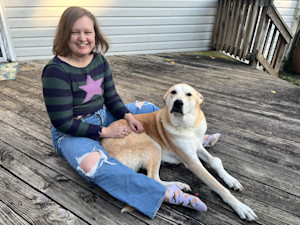
Savannah Admire
Savannah Admire is a writer and pet mom to two dogs and a cat. Under the name Savannah Cooper, she has published poetry in 40 different publications, as well as a poetry book, Mother Viper (2025). When she’s not writing, you can find her reading, taking photos, or volunteering as a content creator for her local community theatre. As a pets writer, she focuses on cat and dog behavior and pet parenthood. She currently lives in Western Maryland.
Related articles
![Dog sitting in a newly unpacked living room with moving boxes around]()
Making a Move? Here’s How to Help Your Dog Adjust to Your New Digs
Your dog loathes moving, too. These tips will make it easier on everyone.
![A woman holding her dog and introducing it to a baby in the arms of a bearded man in a white t-shirt and jeans, in the living room]()
Safety Tips for Living with Babies and Dogs In Healthy Harmony
Handling a houseful of love.
![mom and daughter playing with puppy]()
How to Introduce Your New Dog to Your Kids
They’ll always remember their first childhood pet—this intro is just the beginning.
![dog and cat snuggling together]()
Animal House: How to Intro a New Dog to Your Other Pets
...Without turning your home into a circus.
![Pregnant young woman playing with her Alaskan malamute at home.]()
How to Prepare Your Dog for Your New Baby
Keep these two words in mind: Start now.


